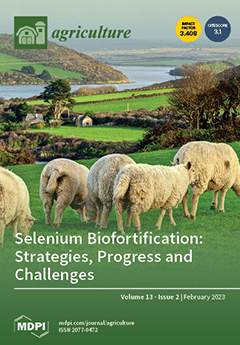The ripening stage can affect consumer preference and the market value of peaches. This study was aimed at developing an objective, effective, and fast procedure for distinguishing the different stages of ripeness of peaches using image texture parameters and models built using traditional
[...] Read more.
The ripening stage can affect consumer preference and the market value of peaches. This study was aimed at developing an objective, effective, and fast procedure for distinguishing the different stages of ripeness of peaches using image texture parameters and models built using traditional machine learning algorithms. The ripeness classes (distinguished using DA-Meter-based nondestructive VIS/NIR method) 0.1, 0.4, and 0.9 for ‘Redhaven’ peaches and 0.1, 0.4, and 1.0 for ‘Royal Glory’ peaches were considered. Fruit weight, ethylene production, total soluble solids content (SSC), titratable acidity (TA), and fruit firmness (FF) were measured. The slice images for each class were acquired. Selected texture parameters from images in color channels
R,
G,
B,
L,
a,
b,
X,
Y, and
Z were used to develop classification models for distinguishing peach ripening stages in pairs. Models were built for combined textures selected from images in all color channels, individual color spaces, and individual color channels using various machine learning algorithms. The ethylene production and SSC was higher in peaches with a ripeness class of 0.1 than in less ripe fruit. The least ripe fruit of ‘Redhaven’ and ‘Royal Glory’ peaches were characterized by the highest fruit firmness. Furthermore, statistically significant differences in SSC between classes 0.1 and 0.9 of ‘Redhaven’ were observed. For ‘Royal Glory’, statistically significant differences in TA were determined between all classes. These differences may be related to classification performance metrics. In the case of ‘Redhaven’ peaches, two extreme ripeness classes 0.1 (the greatest ripeness) and 0.9 (the least ripeness) were correctly classified with the highest accuracy reaching 100% for models built based on textures selected from all color channels (random forest and Bayes net algorithms) and color space lab (random forest). For individual color channels, the accuracy reached 99% for color channel
G (random forest) and color channel
a (logistic). The accuracy of classifying ripening stages 0.1 and 0.4 reached 98% for the model built using textures from all color channels and color space lab (Bayes net). The ripening stages 0.4 and 0.9 were distinguished with an accuracy of up to 96% (all color channels, random forest). The classification of ripening stages of ‘Royal Glory’ peaches reached 100% for all pairs, 0.1 vs. 1.0 (all color channels, color spaces RGB, color space lab, color channel
G, color channel
a), 0.1 vs. 0.4 (all color channels, color space RGB, color space lab), and 0.4 vs. 1.0 (all color channels). The developed procedure can be useful in practice. Distinguishing peaches at different stages of ripeness and the selection of fruit at the optimal stage can be important for consumption and processing.
Full article





